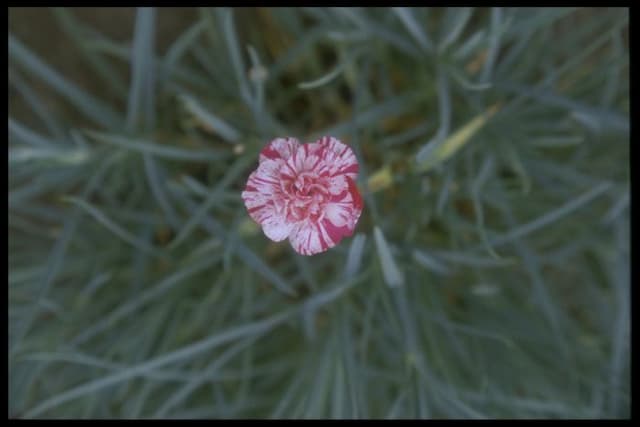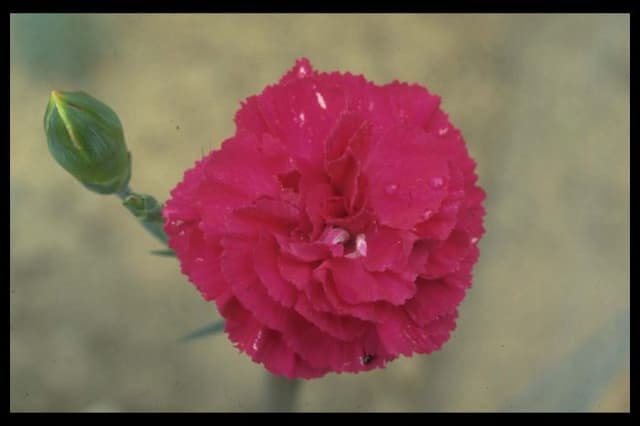Autumn Catchfly Silene schafta

ABOUT
The plant commonly referred to as the Silene schafta showcases a vibrant and lush appearance, characterized by its sprawling cushion-like growth teeming with dense, green foliage. The leaves are small, often needle-like, exuding a fresh green hue, forming a thick mat over the ground. During its flowering season, it blooms with a profusion of striking flowers that provide a splash of color to the garden bed or landscape where it dwells. The flowers of this plant are particularly noteworthy, offering an intense display of deep magenta or pink shades. Each flower is composed of five petals, which often exhibit a slightly notched appearance, radiating out from a central point to form a star-like shape that is both simple and eye-catching. These petals are slender and elongated, contributing to the dynamic visual texture of the floral arrangement. The blooms are borne in small clusters, creating focal points of color amidst the green foliage. While the sizes are excluded from this description, the plant's overall form is mat-forming, indicating that it spreads outwards as it grows, weaving through the garden in a thick carpet. Its overall shape is somewhat rounded, and the foliage remains close to the ground, forming a natural and dense covering that is both attractive and effective at suppressing weeds. The plant displays a hardy and robust nature, thriving in various conditions and often able to endure diverse climate situations. It's often chosen for its ornamental qualities, and its capacity to enliven a garden space with minimal maintenance. The foliage and blooms combine to create a texture and color contrast that is truly pleasing to the eye, making it a popular choice for gardeners and landscapers looking to add a durable yet delicate touch to their outdoor spaces.
About this plant
 Names
NamesFamily
Caryophyllaceae
Synonyms
Autumn Catchfly, Schafter's Silene
Common names
Silene schafta var. splendens, Silene schafta var. compacta.
 Toxicity
ToxicityTo humans
Silene schafta, commonly known as autumn catchfly, is not generally known to be a toxic plant to humans. There is limited information regarding its toxicity, and it is not typically recognized as a plant that causes poisoning when touched or ingested. However, like with any plant material, individuals may have varying sensitivities or allergic reactions, and it is always advisable to prevent ingestion of plant parts if the plant's edibility status is not clear or if the individual is not familiar with it.
To pets
Autumn catchfly (Silene schafta) is not commonly reported to be toxic to pets. There is a lack of substantial evidence to suggest that this plant poses significant health risks to animals. Nonetheless, it is generally recommended to discourage pets from ingesting plants, as individual animals may react differently, and some may have sensitivities or allergies to plant materials that are otherwise not harmful to most pets.
 Characteristics
CharacteristicsLife cycle
Perennials
Foliage type
Evergreen
Color of leaves
Green
Flower color
Pink
Height
1 feet (30 cm)
Spread
1 feet (30 cm)
Plant type
Herb
Hardiness zones
4
Native area
Caucasus
Benefits
 General Benefits
General Benefits- Ornamental Value: Silene schafta, commonly known as autumn catchfly, provides aesthetic beauty in gardens with its vibrant pink flowers.
- Drought Tolerance: Autumn catchfly is able to withstand periods of low water availability, making it suitable for xeriscaping and water-efficient gardening.
- Low Maintenance: This plant requires minimal care once established, making it a convenient choice for gardeners with limited time.
- Pollinator Attraction: The flowers of autumn catchfly attract pollinators such as bees, which are essential for the pollination of many other plants.
- Ground Cover: The dense mat-forming growth habit of autumn catchfly makes it an effective ground cover, reducing weed growth and soil erosion.
- Seasonal Interest: With its late flowering period, it provides color and interest in the garden during late summer to fall when many other plants have finished blooming.
 Medical Properties
Medical PropertiesThis plant is not used for medical purposes.
 Air-purifying Qualities
Air-purifying QualitiesThis plant is not specifically known for air purifying qualities.
 Other Uses
Other Uses- Groundcover: Silene schafta is often used as an effective groundcover in gardens, suppressing weeds and providing a lush, green carpet.
- Erosion Control: The dense mat-forming habit of catchfly helps stabilize soil and prevent erosion on slopes or in areas with loose soil.
- Ornamental Edging: Catchfly's low-growing nature and colorful flowers make it an attractive edging plant for borders and pathways.
- Rock Gardens: The plant is well-suited for rock gardens due to its ability to thrive in well-draining, gravelly soil and contribute to the aesthetic with its delicate flowers.
- Butterfly Gardens: Catchfly can be included in butterfly gardens to attract pollinators, as its nectar-rich flowers are appealing to various butterfly species.
- Fairy Gardens: Due to its petite size and bright, cheerful flowers, catchfly is often used to create whimsical fairy gardens.
- Container Planting: Catchfly is suitable for container planting where garden space is limited, adding a splash of color to patios or balconies.
- Lawn Alternatives: In regions where traditional lawn grasses struggle, catchfly can serve as an alternative, creating a flowering lawn that requires less maintenance.
- Nocturnal Gardens: Catchfly can be a component of nocturnal gardens as some varieties open or become more fragrant in the evening, attracting night-time pollinators.
- Green Roofing: The plant's ability to withstand drought and its low profile make it suitable for green roofing projects, contributing to urban biodiversity and insulation.
Interesting Facts
 Feng Shui
Feng ShuiSilene schafta is not used in Feng Shui practice.
 Zodiac Sign Compitability
Zodiac Sign CompitabilitySilene schafta is not used in astrology practice.
 Plant Symbolism
Plant Symbolism- Perseverance: Silene schafta, commonly known as the Autumn Catchfly, often blooms in late summer to autumn, representing the ability to persevere and thrive even as the seasons change and conditions become more challenging.
- Resilience: The Autumn Catchfly is a hardy plant that can survive in tough soil conditions, symbolizing resilience and the capacity to withstand hardship.
- Lasting Affection: With its extended blooming period, the Autumn Catchfly may signify enduring love or affection that lasts over time.
- Survival: As a plant that can handle neglect and still flourish, Autumn Catchfly embodies the principle of survival and adaptability in adverse situations.
 Water
WaterFor the catchfly plant (Silene schafta), water thoroughly when the top inch of soil feels dry. This might mean watering approximately once a week, but frequency can vary based on weather conditions and soil drainage. When watering, provide a deep soaking to encourage deep root growth, using about one gallon of water per plant to ensure the moisture reaches the root zone. Adjust the amount during hotter, dryer periods or cooler, wetter seasons; in general, less frequent watering is needed during the fall and winter.
 Light
LightCatchfly (Silene schafta) thrives in full sun, requiring at least six hours of direct sunlight daily. A spot that receives morning sunlight and some afternoon shade can be beneficial in hotter regions to prevent scorching. However, it is adaptable to partial shade, especially in hot climates, where it appreciates some protection during the peak heat of the day.
 Temperature
TemperatureCatchfly (Silene schafta) can tolerate a wide range of temperatures but prefers conditions between 60 and 75 degrees Fahrenheit. It is capable of withstanding a minimum temperature of around 30 degrees Fahrenheit but may suffer damage if temperatures dip below freezing. Maximal growth and flowering occur within the ideal temperature range.
 Pruning
PruningPrune catchfly (Silene schafta) to remove dead or damaged stems and spent flowers to encourage a second bloom and to maintain plant health and appearance. This is usually done after the first flush of flowers fades, around mid-summer. Pruning can also help promote denser growth and a more compact form, which can be especially beneficial after winter dieback.
 Cleaning
CleaningAs needed
 Soil
SoilThe Autumn Catchfly prefers a well-draining soil mix with some organic matter, such as a blend of loam, compost, and sand. The ideal soil pH for Silene schafta is slightly alkaline, around 7.0 to 7.5.
 Repotting
RepottingAutumn Catchfly does not require frequent repotting; it can typically be repotted every two to three years or as needed when it outgrows its current container.
 Humidity & Misting
Humidity & MistingAutumn Catchfly thrives in average humidity levels and does not require specific humidity adjustments when grown in its ideal outdoor conditions.
 Suitable locations
Suitable locationsIndoor
Place in bright light, minimal water, well-drained soil.
Outdoor
Full sun to part shade, well-draining soil, water sparingly.
Hardiness zone
4-8 USDA
 Life cycle
Life cycleSilene schafta, commonly known as autumn catchfly, begins its life as a seed, which, once sown and exposed to appropriate temperature and moisture conditions, germinates to produce a seedling. The seedling develops into a vegetative plant with a basal rosette of leaves during its growth phase, followed by the formation of stems and foliage. As it matures, the plant enters the flowering stage, typically in late summer to early autumn, producing pink to magenta flowers that attract pollinators. Following pollination, the plant produces seed capsules containing seeds that, when mature, are dispersed by wind or gravity. These seeds enter a period of dormancy through the winter until environmental conditions are right for the next cycle of germination. Autumn catchfly is a perennial plant, which means it can live for several years, growing and flowering in successive seasons.
 Propogation
PropogationPropogation time
Spring to early summer
The most popular method of propagation for the Silene schafta, commonly known as Autumn catchfly, is by division. This is typically done in the spring as the new growth appears or in the autumn. To propagate by division, a gardener should carefully lift the entire clump out of the ground using a spade or fork. Once out of the ground, the clump should be gently teased apart or cut into smaller sections, making sure that each section has several shoots and a portion of the root system. These divisions can then be immediately replanted in the garden, spaced at least 6 to 12 inches apart (15 to 30 centimeters) to give them room to grow. The soil should be kept moist until the new plants are well established.




![Pink [Coconut Sundae]](/_next/image?url=https%3A%2F%2Fplants-admin.emdemapps.com%2Fimages%2Fplants%2F%2Fimages%2F604b5d09d4fd1.png&w=640&q=75)




